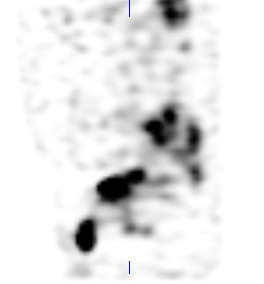The radiation oncologists wanted to asses the renal function within this patient, prior to having radiation therapy for endometrial cancer. The big problem was that the patient has a left pelvic kidney, and they feared that it would be ablated during the treatment. The CT image below details where the kidney lies within the pelvis.
 |
| Fig. 1 Sagittal slice of the patient. Note the ovoid shaped organ on the bottom right of the image just below the sacrum. |
We perform our renal scans mainly with DTPA, along with corresponding blood samples at time 0 pre-injection, 1 hour post injection and at 3 hours post injection. We combine this with the Gates analysis method to get an idea of the overall kidney function. The images below are what we have obtained using the DTPA and blood sampling method. All dynamic and static images with respect to the kidneys are performed in the supine position.
 |
| Fig. 3 Split renal function (differential) is primarily determined by the camera method. |
We perform continuous imaging over a 20 minute period and then static views of pre and post void kidneys (standing), along with the injection site to assess for residual activity.
In this case here, as you can see from the images above, the assessment of the right kidney seems to be straight forward, but the problem is the assessment of the left pelvic kidney. In Fig. 3, over time, it becomes obscured by the bladder.
(Note, I have tried to load the dynamic acquisition to demonstrate this more clearly, but could not get the correct intensity to illustrate this event)
The problem is, our reporting radiologist could not be confident in reporting the GFR values nor the split renal function, since the regions of interest (ROI's) would incorporate the expanding bladder and would result in an inaccurate estimation of these values.
Essentially our reporting radiologist spoke with the requesting radiation oncologists to consult them with regards to the imaging. To make a long story short, in the end, the GFR values were not as important as the split renal function. Thus to avoid the bladder uptake, DMSA was used to scan the kidneys again and a geometric mean was used to determine the split renal function. Below are the images of the DMSA scan.
 |
| Fig. 5 Anterior and posterior images of the kidneys were obtained using DMSA. A geometric mean was used to better estimate the split renal function. Imaging was performed in the supine position. |
The use of the DMSA essentially limited the amount of bladder activity seen, but provided good parenchymal imaging to allow for the split renal function to be calculated.































